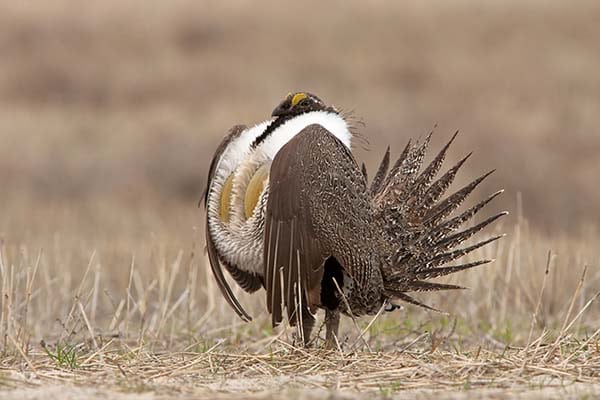
Once numbering in the tens of millions, sage-grouse populations today have decreased drastically as a result of development and habitat loss.
In recent years, the sage-grouse was proposed for protection under the federal Endangered Species Act. A historic conservation effort across 11 Western states is helping reverse the decline and keep the species from becoming endangered. That effort is threatened by politicians who want to hijack the sage-grouse conservation plans and transfer control of public land to states.
Sagebrush Steppe: Good for Sage-Grouse, Mule Deer, and People
The sage-grouse depends on large expanses of healthy sagebrush steppe. This habitat dominates much of the West’s countryside, thriving in the arid deserts through dry, hot summers and cold winters. The sagebrush is one of the dominant plants in the steppe and provides food and shelter for many species. Besides the sage-grouse, the sagebrush steppe provides habitat for 350 other species including mule deer, pronghorn antelope and elk, and numerous nongame animals. These lands also provide a significant public opportunity for hunting and other recreational activities like hiking, biking, and camping.
States & Federal Government Work Together to Protect Sage-Grouse
In order to keep sage-grouse off of the Endangered Species List, Western states and the federal government worked together to conserve the species and its habitat. The ten states in sage-grouse country adopted plans at the state-level to adopt conservation actions on private and state land and provide funding to protect habitat private land. At the same time, the federal sage-grouse plan was created to establish protections for the species on Bureau of Land Management and Forest Service lands.
The state and federal plans were written through an unprecedented effort by land managers, conservationists, hunters, landowners, and other stakeholders to work together and find common ground. This coordinated effort being fully implemented was key to the Department of Interior’s determination that the sage-grouse did not need to be listed under the Endangered Species Act in 2015.
Needed Now: Implementing the State & Federal Sage-Grouse Plans
The State of Montana is leading on many aspects of sage-grouse conservation on private and state trust land. However, the state plan does not account for the roughly 35 percent of sage-grouse habitat that is on federal public lands. Sage-grouse conservation is not an either-or choice between federal plans or the state plans: it will take aggressive effort and full funding for both state and federal plans in order to succeed.
The Risk: Politicians Trying to Throw Out the Plans and Take Over Public Land
Some in Congress have seized the sage-grouse issue as a way to push an extreme agenda to transfer public land management away from the federal government. Bills have been introduced in Congress that would remove protections for sage-grouse and allow state governors to invalidate federal land management plans with the stroke of a pen. Multiple-use land management that protects public input, wildlife habitat, and public access would get thrown out.
Now is the time for hunters and hikers, backpackers and mountain bikers, ranchers and farmers, and all who value our public lands to draw a hard line and let those our elected officials know that the sage grouse shouldn’t be used to score political points.
